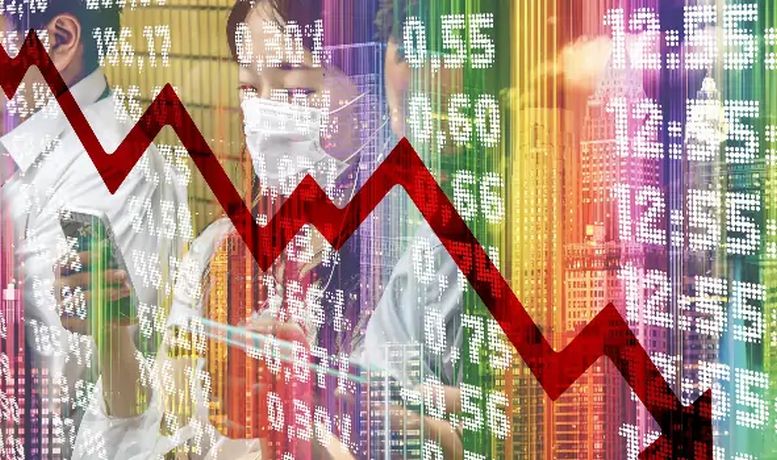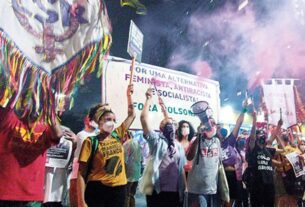Guizhou province’s distress signal opens new front in country’s debt meltdown.
China’s economy suffered a disastrous 2022. Xi Jinping, months into his unprecedented third term as absolute ruler, is therefore desperate for an economic rebound to dispel the gloom that grips the Chinese and global capitalists and restore “confidence.” Earlier this year, global capitalism had largely bought into the “China is back” narrative, hoping for strong growth in the world’s number two economy as a counterweight to recession risks in the Western capitalist economies. But Xi’s post-pandemic rebound is already fizzling out.
Before looking at the data, let’s first re-cap on some of the conclusions from discussions among the Chinese Marxists and supporters of ISA about the state of the economy. We have been consistently sceptical towards predictions of a strong economic recovery this year.
When the National People’s Congress in March formalized this year’s GDP target at “around 5 percent” we were struck by how low the figure is (it’s China’s lowest GDP target since 1991). Many global forecasters are making higher predictions of six or more percent — what does Xi’s regime know that others don’t?
In our discussions, we identified two ways the Chinese economy could reach the 5 percent target: through a significant further run up in China’s already unsustainable debt load or through cooking the books. Probably both methods will be used. In numerous articles, Marxists have explained that China’s economic malaise of the past few years has not merely been the result, as some commentators believe, of Xi’s ultra-repressive “zero COVID” doctrine, although that surely made things worse.
The root causes of the current deep crisis are to be found in the exhaustion of China’s debt-driven state capitalist growth model. It has reached the end of the road. This growth model was based on massive infrastructure investments (including trillions of dollars wasted on white elephants) and vastly inflated property prices, mirroring Japan’s former bubble economy, but worse.
This formula has driven China’s economy for the past two decades, especially since the global crisis of 2008–9 when a historic never-to-be-repeated Chinese stimulus package shook the world (“when China saved world capitalism” as the saying goes). Behind this was the mother of all debt explosions, which is where we are today. This is something we predicted, but even some so-called Marxists denied because, whether befuddled by CCP propaganda or not, they claimed, “China’s state has unique abilities.”
The Chinese dictatorship’s control of the banking system, plus the media, the internet, the judiciary, other significant levers of financial and political control, and not least extensive censorship with the ability to disappear anyone who blows a whistle or poses embarrassing questions, does give them a degree of control that “normal” capitalist regimes don’t have. But it doesn’t cancel out the law of gravity or — more pertinently — the law of value.
For more than a decade, China’s growth has been dependent on rapidly increasing debt. When the government has shifted its focus to “deleveraging,” applying the brakes to spiralling debt levels, the economy has nosedived. We saw this clearly in the crackdown on debt in the property sector, which triggered the real estate slump of the past two years. The so-called recovery of 2023 is merely continuing on the same track, with China’s debt-to-GDP ratio surging 7.7 percentage points in the first quarter of 2023 to the record level of 290 percent, according to People’s Bank of China data.
The CCP has been postponing a debt crisis for several years by shuffling potential time bombs from one part of the financial system to another in a massive hide-and-seek exercise. But the current financial turmoil in China’s local governments — the engine rooms of its state capitalist debt-for-infrastructure model — could become one challenge too much for Xi’s regime. The emerging debt crisis in Guizhou, with a string of other highly-indebted provinces lining up behind it, may not be so easy for Beijing to “magic away” through yet more financial trickery.
Local governments squeezed
The official first quarter GDP number grew a reassuring 4.5 percent above the same quarter in 2022. Or did it? As always, the accuracy of China’s official data cannot be trusted. This is a fragile recovery, heavily dependent on “life support” in the form of more state-dictated infrastructure projects financed by debt.
Eighteen provinces announced a total of nearly 10 trillion yuan (US$1.4 trillion) in new infrastructure construction for 2023, according to a Global Times report (28 February, 2023). The remaining 13 provinces had not disclosed their investment figures, it said.
But provincial and local governments are running out of money. Of 31 provinces, 22 saw declines in revenue in 2022, according to official data. Trillions of yuan in debt servicing costs have made a gaping hole in local government budgets. This accounts for more than a third of all spending by some city governments. Land sales, which traditionally made up a quarter of local government revenue, collapsed by 23.3 percent last year as a side effect of the property crisis. This meant a combined loss of about 2 trillion yuan (US$288 billion) for local governments.
The result is a tsunami of job cuts, pay cuts and service cuts across the country. Bus services have been closed down or temporarily suspended in more than 20 cities with bus companies unable to buy fuel or pay wages. In Hebei province, fuel subsidies for winter heating were cancelled. Schools, hospitals, government buildings and other local government assets have been monetized and sold off to private actors in order to raise cash.
“Many of my colleagues’ salaries were delayed, and it was hard because we have families to feed,” a government employee in Jiangxi province told Al Jazeera. “This was unimaginable before.”
The CCP’s economic strategy is to double down with yet another infrastructure binge in the hope this will ignite economic growth and stimulate consumer spending to take over as the economy’s driving force. But the trend of recent years shows this is not happening, rather the opposite.
This year’s recovery is hamstrung by sluggish household consumption and a preference to save rather than spend. This should not surprise anyone. Chinese workers and the middle class are extremely anxious over their economic security: jobs, wages, pensions and losses from the housing downturn (the so-called negative wealth effect). In April, youth unemployment hit a record 20.4 percent, which means over 20 million under-25s are jobless. The so-called informal sector, of deregulated and precarious employment, now accounts for 56 percent of the whole labour force (up from 33 percent in 2004).
The capitalists are also insecure. Private businesses are reluctant to commit to new investments because confidence in the recovery and in the economic management skills of Xi’s dictatorship is close to rock bottom. The “Year from Hell” that was 2022 has still not been digested.
This mood is reflected in the first quarter data with state sector investment growing 10 percent, compared to only 0.6 percent growth in the private sector. The private sector accounts for 60 percent of China’s GDP, 80 percent of urban employment and 90 percent of new jobs. This helps to explain the stubbornly high rate of youth unemployment, which has remained over 16 percent for a year.
“Revenge spending”?
A wave of “revenge spending” was predicted by economists when Xi chaotically scrapped the “zero COVID” regime last December, finally releasing people back to some form of “normalcy.” But the anticipated consumption wave is conspicuous by its absence. This was acknowledged even by the CCP’s Politburo at its meeting on 28 April, which admitted the problems of insufficient demand and weak “internal dynamics.”
Instead, it is bank deposits that are growing to record levels. Even the most gung-ho of foreign investors have taken notice. Estée Lauder, Starbucks and Qualcomm, all of which count China as one of their biggest markets, have warned of falling sales.
Nomura’s chief China economist Ting Lu told Reuters: “The 8 trillion yuan surge in new household deposits in 2022 triggered some bullish market views that this … would lead to a massive release of post-pandemic pent-up demand… However, new household deposits rose further [in Q1 2023].”
According to the People’s Bank of China, deposits held by households grew by 9.9 trillion yuan (US$1.4 trillion) in the first quarter, an increase of 27 percent from a year ago.
Therefore, economists are especially sceptical towards China’s retail sales figures, which reported 5.8 percent growth in the first quarter. That household consumption is subdued, with the exception of services (traveling and dining out to celebrate the end of three years of zero COVID), is also confirmed by the world’s lowest inflation rate.
China’s annual consumer price index (CPI) only increased 0.1 percent in April. This “inflation-less recovery,” as The Economist magazine calls it, suggests that companies are under pressure not to put up prices due to weak demand.
Prices at the factory gate as shown by the producer price index (PPI) are in deflationary territory. April’s PPI fell to its lowest level in three years, minus 3.5 percent. Deflation, or falling prices, can be just as destabilizing as inflation. That’s especially true in economies with high debt levels, like China. While inflation eats away at debt, by stripping money of its value, deflation has the opposite effect and makes the cost of repaying debts higher in relative terms.
Japan has wrestled with deflation for more than 30 years — a period known as its “lost decades.” In this time its economy stagnated, sliding from 17.7 percent of global GDP in 1995 to 6 percent today. The build-up of debt in China, which outstrips Japan by a wide measure, followed by the implosion of the Chinese housing bubble in 2021, and now the even more serious debt crisis erupting in local governments, which stand for 90 percent of all government spending, threatens a Japanese economic scenario in China.
The property market is still shrinking despite government support measures adopted late last year. While the rate of decline in property sales appears to have stabilised, after imploding last year, investment in the sector fell by 6.2 percent in January-April, following a 10 percent fall in 2022. New housing starts measured by floor area fell by 19.2 percent in Q1 from the already low base of a year ago.
Guizhou’s S.O.S.
The local government debt crisis signalled by events in Guizhou, where some form of disguised central government bailout looks to be underway, marks the opening of a scary new front in China’s battle to prevent a financial collapse. Cities and prefectures in Guizhou, a province with 38 million inhabitants, have racked up “hidden debts” — those funnelled through off-balance-sheet entities — of 1.31 trillion yuan (US$190 billion). This is mainly through repeated infrastructure programs.
In April, the Guizhou provincial government sent Beijing an “S.O.S.” A statement on its official website said that “debt has become a major and urgent problem facing local governments [in the province]” and admitting that “it is impossible to effectively solve [the debt problem] by relying on [the local government’s] own ability.” The statement was deleted within hours.
Guizhou is to the local government debt crisis what Evergrande was to the property crisis: just the tip of the iceberg. That said, defusing the local government debt crisis will be far more difficult than dealing with the property slump. Official local government debt has nearly doubled over the past five years to 35.3 trillion yuan (US$5.14 trillion) according to the IMF. That is more than 120 percent of all local government revenue.
But then there are the debts racked up by local government financial vehicles (LGFVs), off-balance-sheet entities that are the main conduits for spending on construction and infrastructure. Thousands of these poorly regulated but government-owned companies are a legacy of the giant 2008–09 stimulus package, which cemented their role at the economic heart of China’s state capitalism. LGFV debt rose to 57 trillion yuan (US$8.3 trillion) in 2022, which is 48 percent of China’s GDP, according to the IMF.
China’s internal debt crisis has many similar features to the external debt crisis that CCP policies have helped to create, with Beijing forced to dole out multiple bailouts to its “family” of Belt and Road Initiative (BRI) countries in Africa, Asia and Latin America. Projects that were designed to push growth and increase the economic power of Chinese capitalism and its dictatorship, have instead become a drain on resources from which it is hard to pull back.
Xi’s regime is under massive pressure from the imperialist Cold War, the global geopolitical battle between two failing superpowers, both beset by economic and political crises. This conflict is driving the de-globalization process, which in turn is compounding the economic woes of global capitalism and increasing military threats. Given this international climate, the CCP is falling back on its traditional recipe for boosting GDP growth: pushing cash-starved local governments to take on more debt.
At the same time, it imposes more austerity on the populace, with cuts in government payrolls and attacks on pensions. Rather than the “revenge spending” that capitalism hoped for, the emergence from China’s pandemic nightmare may see workers and youth unleash revenge of another kind.




